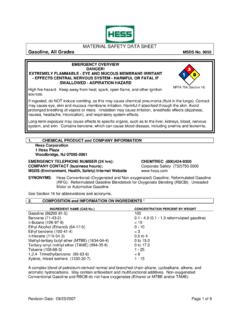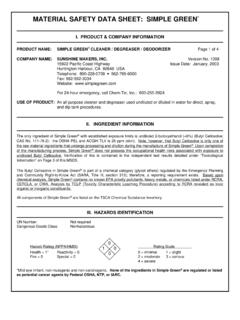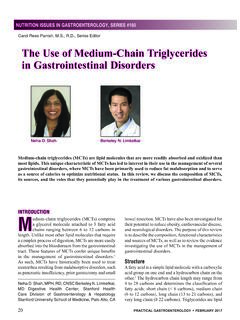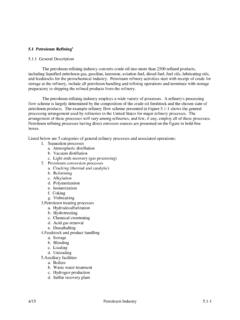Transcription of MATERIAL SAFETY DATA SHEET Hess 5W30 Motor Oil
1 MATERIAL SAFETY DATA SHEET Hess 5W30 Motor Oil MSDS No. 9683 EMERGENCY OVERVIEW CAUTION! OSHA/NFPA COMBUSTIBLE LIQUID - SLIGHT TO MODERATE IRRITANT EFFECTS CENTRAL NERVOUS SYSTEM HARMFUL OR FATAL IF SWALLOWED Moderate fire hazard. Avoid breathing vapors or mists. May cause dizziness and drowsiness. May cause moderate eye irritation and skin irritation (rash). Long-term, repeated exposure may cause skin cancer. If ingested, do NOT induce vomiting, as this may cause chemical pneumonia (fluid in the lungs). NFPA 704 (Section 16) 1. CHEMICAL PRODUCT AND COMPANY INFORMATION Hess Corporation 1 Hess Plaza Woodbridge, NJ 07095-0961 EMERGENCY TELEPHONE NUMBER: VALVOLINE: 800-247-5263 COMPANY CONTACT (business hours): Valvoline Info: 606-357-7847 Corporate EHS 732-750-6000 MSDS Internet Website: SYNONYMS: Valvoline Product Code 52670453 This product is manufactured by The Valvoline Company and packaged under the Amerada Hess ( Hess ) label.
2 The information in this MSDS has been developed by The Valvoline Company, MSDS No. , date 5/11/99. See Section 16 for abbreviations and acronyms. 2. COMPOSITION and CHEMICAL INFORMATION ON INGREDIENTS INGREDIENT NAME (CAS No.) CONCENTRATION PERCENT BY WEIGHT Aliphatic Petroleum Distillates (64742-65-0) Detergent/ Dispersant Engine Oil Package N/A Zinc Compounds N/A Petroleum-based lubricating oil with detergent/dispersant engine oil package with zinc compounds. 3. HAZARDS IDENTIFICATION EYES May cause mild eye irritation. Symptoms include stinging, tearing, and redness. SKIN May cause mild skin irritation. Prolonged or repeated contact may dry the skin. Symptoms include redness, burning, drying and cracking of the skin, and skin burns. Additional symptoms of skin contact include: acne. Passage of this MATERIAL into the body through the skin is possible, but it is unlikely that this would result in harmful effects during safe handling and use.
3 Revision Date: 7/1/2006 Page 1 of 7 MATERIAL SAFETY DATA SHEET Hess 5W30 Motor Oil MSDS No. 9683 INGESTION Swallowing small amounts of this MATERIAL during normal handling is not likely to cause harmful effects. Swallowing large amounts may be harmful. INHALATION It is possible to breathe this MATERIAL under certain conditions of handling and use (for example, during heating, spraying, or stirring). Breathing small amounts of this MATERIAL during normal handling is not likely to cause harmful effects. Breathing large amounts may be harmful. Symptoms usually occur at air concentrations higher than the recommended exposure limits. CHRONIC EFFECTS and CARCINOGENICITY This MATERIAL is not listed as a carcinogen by IARC, NTP, or OSHA. Used Motor oil has been shown to cause skin cancer in laboratory animal continually exposed by repeated applications. Avoid prolonged or repeated skin contact. MEDICAL CONDITIONS AGGRAVATED BY EXPOSURE Irritation from skin exposure may aggravate existing open wounds, skin disorders, and dermatitis (rash).
4 4. FIRST AID MEASURES EYES If symptoms develop, move individual away from exposure and into fresh air. Flush eyes gently with water while holding eyelids apart. If symptoms persist or there is visual difficulty, seek medical attention. SKIN Remove contaminated clothing. Wash exposed area with soap and water. If symptoms persist, seek medical attention. Launder clothing before reuse. INGESTION Seek medical attention. If individual is drowsy or unconscious, do not give anything by mouth; place individual on the left side with the head down. Contact a physician, medical facility, or poison control center for advice about whether to induce vomiting. If possible, do not leave individual unattended. INHALATION Remove person to fresh air. If person is not breathing provide artificial respiration. If necessary, provide additional oxygen once breathing is restored if trained to do so. Seek medical attention immediately. Note to Physicians Acute aspiration of large amounts of oil-laden MATERIAL may produce a serious aspiration hazard.
5 Patients who aspirate these oils should be followed for the development of long-term sequelae. Repeated aspiration of mineral oil can produce chronic inflammation of the lungs ( lipoid pneumonia) that may progress to pulmonary fibrosis. Symptoms are often subtle and radiological changes appear worse than clinical abnormalities. Occasionally, persistent cough, irritation of the upper respiratory tract, shortness of breath with exertion, fever, and bloody sputum occur. Inhalation exposure to oil mists below current workplace exposure limits is unlikely to cause pulmonary abnormalities. Preexisting disorders of the following organs (or organ systems) may be aggravated by exposure to this MATERIAL : skin. 5. FIRE FIGHTING MEASURES FLAMMABLE PROPERTIES: FLASH POINT: oF ( oC) COC AUTOIGNITION POINT: No data EXPLOSIVE LIMITS (%): No data Revision Date: 7/1/2006 Page 2 of 7 MATERIAL SAFETY DATA SHEET Hess 5W30 Motor Oil MSDS No. 9683 FIRE AND EXPLOSION HAZARDS Never use welding or cutting torch on or near drum (even empty) because product (even just residue) can ignite explosively.
6 No special fire hazards are known to be associated with this product. Dense smoke may be generated while burning. HAZARDOUS PRODUCTS OF COMBUSTION May form: carbon dioxide and carbon monoxide, oxides of sulfur, nitrogen and phosphorous, various hydrocarbons. EXTINGUISHING MEDIA SMALL FIRES: Any extinguisher suitable for Class B fires, dry chemical, CO2, water spray, fire fighting foam, or Halon. LARGE FIRES: Water spray, fog or fire fighting foam. Water may be ineffective for fighting the fire, but may be used to cool fire-exposed containers. FIRE FIGHTING INSTRUCTIONS Small fires in the incipient (beginning) stage may typically be extinguished using handheld portable fire extinguishers and other fire fighting equipment. Firefighting activities that may result in potential exposure to high heat, smoke or toxic by-products of combustion should require NIOSH/MSHA- approved pressure-demand self-contained breathing apparatus with full facepiece and full protective clothing.
7 Isolate area around container involved in fire. Cool tanks, shells, and containers exposed to fire and excessive heat with water. For massive fires the use of unmanned hose holders or monitor nozzles may be advantageous to further minimize personnel exposure. Major fires may require withdrawal, allowing the tank to burn. Large storage tank fires typically require specially trained personnel and equipment to extinguish the fire, often including the need for properly applied fire fighting foam. See Section 16 for the NFPA 704 Hazard Rating. 6. ACCIDENTAL RELEASE MEASURES ACTIVATE FACILITY S SPILL CONTINGENCY OR EMERGENCY RESPONSE PLAN. Evacuate nonessential personnel and remove or secure all ignition sources. Consider wind direction; stay upwind and uphill, if possible. Evaluate the direction of product travel, diking, sewers, etc. to confirm spill areas. Spills may infiltrate subsurface soil and groundwater; professional assistance may be necessary to determine the extent of subsurface impact.
8 Carefully contain and stop the source of the spill, if safe to do so. Protect bodies of water by diking, absorbents, or absorbent boom, if possible. Do not flush down sewer or drainage systems, unless system is designed and permitted to handle such MATERIAL . The use of fire fighting foam may be useful in certain situations to reduce vapors. The proper use of water spray may effectively disperse product vapors or the liquid itself, preventing contact with ignition sources or areas/equipment that require protection. Take up with sand or other oil absorbing materials. Carefully shovel, scoop or sweep up into a waste container for reclamation or disposal - caution, flammable vapors may accumulate in closed containers. Response and clean-up crews must be properly trained and must utilize proper protective equipment (see Section 8). SMALL SPILL: Absorb liquid on vermiculite, floor absorbent or other absorbent MATERIAL . Persons not wearing proper personal protective equipment should be excluded from area of spill.
9 Revision Date: 7/1/2006 Page 3 of 7 MATERIAL SAFETY DATA SHEET Hess 5W30 Motor Oil MSDS No. 9683 LARGE SPILL: Prevent run-off to sewers, streams, or other bodies of water. If run-off occurs, notify authorities as required, that a spill has occurred. Persons not wearing proper personal protective equipment should be excluded from area of spill until clean-up has been completed. 7. HANDLING and STORAGE HANDLING PRECAUTIONS Handle as a combustible liquid. Keep away from heat, sparks, and open flame! Electrical equipment should be approved for classified area. Bond and ground containers during product transfer to reduce the possibility of static-initiated fire or explosion. Special slow load procedures for "switch loading" must be followed to avoid the static ignition hazard that can exist when higher flash point MATERIAL (such as fuel oil) is loaded into tanks previously containing low flash point products (such as this product) - see API Publication 2003, "Protection Against Ignitions Arising Out Of Static, Lightning and Stray Currents.
10 STORAGE PRECAUTIONS Keep away from flame, sparks, excessive temperatures and open flame. Use approved vented containers. Keep containers closed and clearly labeled. Empty product containers or vessels may contain explosive vapors. Do not pressurize, cut, heat, weld or expose such containers to sources of ignition. Store in a well-ventilated area. This storage area should comply with NFPA 30 "Flammable and Combustible Liquid Code". Avoid storage near incompatible materials. The cleaning of tanks previously containing this product should follow API Recommended Practice (RP) 2013 "Cleaning Mobile Tanks In Flammable and Combustible Liquid Service" and API RP 2015 "Cleaning Petroleum Storage Tanks". WORK/HYGIENIC PRACTICES Emergency eye wash capability should be available in the near proximity to operations presenting a potential splash exposure. Use good personal hygiene practices. Avoid repeated and/or prolonged skin exposure. Wash hands before eating, drinking, smoking, or using toilet facilities.











